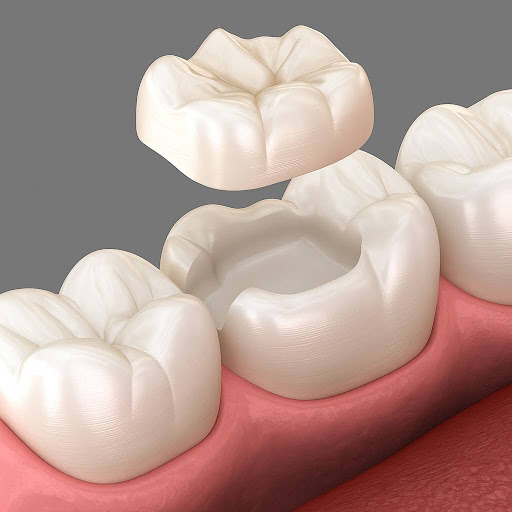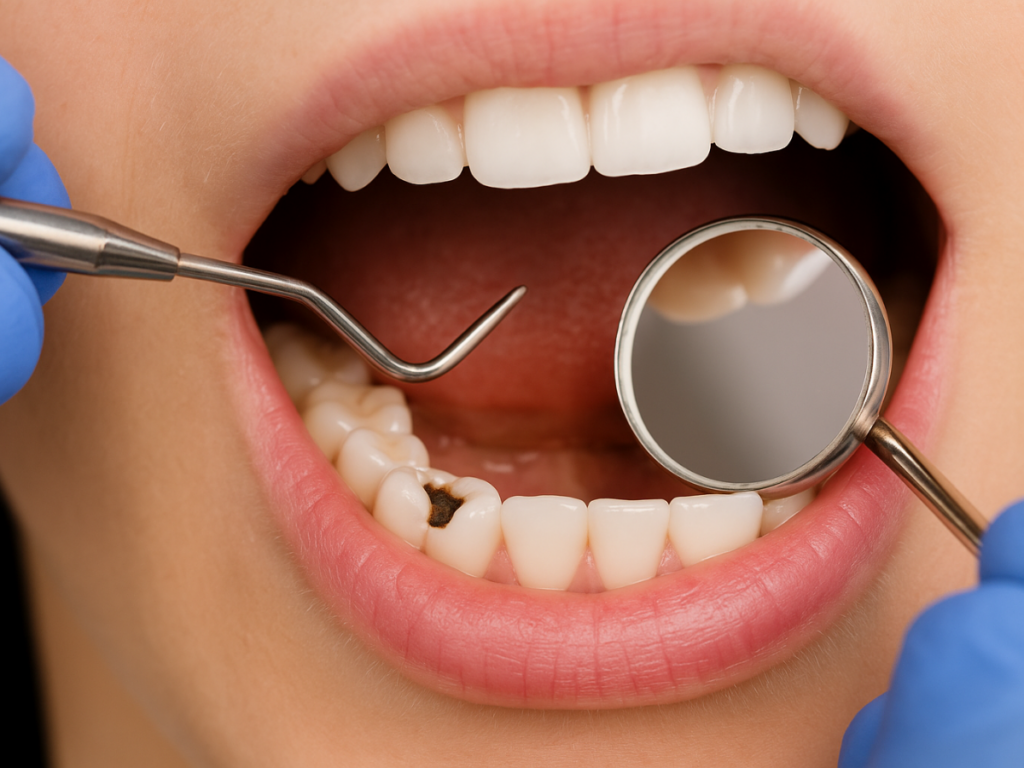When it comes to restoring a damaged tooth, both inlays and crowns are trusted options—but they’re not interchangeable. Each serves a specific purpose depending on the extent of tooth decay, the strength of the surrounding enamel, and your long-term oral health goals.
Understanding the difference between inlays and crowns can help you feel more confident about your treatment plan. While both are custom-made restorations, they vary in how much of the tooth they cover, how they’re placed, and how they impact your bite and smile.
At Elizabeth L. Wakim, DDS, we take the time to explain all your options and tailor each recommendation to what’s best for your dental health—not just what’s available. We use advanced materials and precise imaging to ensure your restoration looks natural, fits perfectly, and lasts for years to come.
What Are Inlays?

Dental inlays are custom restorations used to repair mild to moderate damage within the grooves of a tooth—typically the chewing surfaces of molars or premolars. They’re ideal when a cavity is too large for a filling but doesn’t require full coverage like a crown.
Unlike traditional fillings, inlays are fabricated outside the mouth—usually in a dental lab or with in-office CAD/CAM systems—and then bonded securely into place. This process allows for a more precise fit and a stronger, longer-lasting result. In fact, composite inlays have shown 5-year survival rates of around 91%, making them a reliable option for preserving tooth structure and function.
Inlays may be recommended if you have:
- A cavity between the cusps of a back tooth
- Decay that’s too extensive for a regular filling
- A cracked or worn-down filling that needs to be replaced
- Strong surrounding enamel that doesn’t require full coverage
What Are Crowns?

Dental crowns are full-coverage restorations designed to protect and rebuild a tooth that’s significantly weakened, fractured, or decayed. Unlike inlays, which fit within the grooves of a tooth, crowns cover the entire visible surface—restoring both function and appearance. Among the available materials, metal crowns are known for having the longest survival rates, making them a durable choice for patients who prioritize longevity, especially on back teeth where strength matters most.
Crowns are commonly recommended when a tooth:
- Has extensive decay or a very large cavity
- Is cracked, broken, or severely worn down
- Has undergone root canal treatment
- Needs extra support for a dental bridge
- Is misshapen or discolored and affects your smile
Inlays vs Crowns: Key Differences

Which Is Right for You?
Choosing between an inlay and a crown involves more than just the size of the cavity. With an estimated 2.3 billion people affected by dental caries in their permanent teeth, protecting what remains is essential. The goal is to preserve healthy tooth structure, prevent further damage, and support your long-term oral health. Your dentist will evaluate several factors to recommend the right solution:
- Location and Aesthetics: For visible teeth or areas close to the gum line, your dentist may recommend porcelain inlays, ceramic inlays, or full crowns depending on what blends best with your natural smile. Inlays are often preferred for a more conservative procedure that retains natural tooth structure.
- Bite and Wear Habits: If you have a history of teeth grinding or need a restoration on a load-bearing tooth, crowns and onlays provide comprehensive protection. Onlays are sometimes called “partial crowns” because they cover one or more cusps for added durability.
- Long-Term Outlook: Your dentist considers your history of dental visits, oral hygiene habits, and any risk of further decay. A crown may be the better treatment choice for a severely compromised tooth, while inlays or onlays might be enough for repairing decay in decayed teeth with more remaining structure.
A personalized treatment plan balances aesthetics, strength, and longevity—while preserving as much healthy tissue as possible. Material choices like ceramic or porcelain-fused-to-metal, along with the condition of the surrounding area, all factor into the decision. For a closer look at how these options support long-term function and comfort, see our approach to restorative dentistry.
What to Expect During Treatment
Whether you’re getting an inlay, onlay, or custom-made crown, the process is carefully designed to restore the affected tooth with precision and comfort. Here’s what to expect:
1. Impressions or Digital Scans
At your first appointment, we’ll take impressions or use digital scanning to capture the exact shape of the prepared tooth, nearby posterior teeth, and surrounding teeth. This ensures your inlay, onlay, or crown fits your bite and restores the tooth’s surface—whether that means part of the enamel or the entire biting surface.
2. Temporary Protection (If Needed)
If your permanent crown or restoration isn’t ready right away, we may place a temporary version to protect the damaged or decayed tooth. This step prevents sensitivity and allows for normal teeth biting while your final piece is crafted from durable material like ceramic or porcelain.
3. Final Placement and Bonding
Once your solid piece is ready, we’ll place it using dental bonding or cement. For onlays and crowns, we ensure the fit is precise—especially when the onlay covers one or more cusps of the tooth. The result is a seamless restoration that blends with your natural smile and provides extensive coverage and strength.
Caring for Your Inlay or Crown
Like any dental restoration, inlays and onlays—along with custom crowns that restore the entire tooth—need consistent care to stay effective. With good habits and regular dental check-ups, your restoration can continue protecting your natural tooth structure for years.
- Brush and floss daily: Practicing good oral hygiene prevents plaque and decay around the edges of your dental filling or permanent crown. Use a soft-bristled toothbrush and gentle flossing to clean thoroughly without irritating the gum line.
- Avoid chewing hard foods or ice: Even though dental onlays and crowns are made from durable materials, crunching on hard foods can crack or dislodge them—especially if the prepared tooth was already severely damaged.
- Keep up with regular dental check-ups: Routine exams help your dentist assess how well your restorative options are holding up and catch issues before they worsen. They’ll also consider evolving patient preferences, bite changes, or wear on surrounding teeth.
- Comfort during treatment and beyond: Most restorations are placed under local anesthetic for a comfortable experience. But your care doesn’t stop after the first appointment—long-term success depends on continued care and follow-up.
- Backed by research, including systematic reviews of dental restoration outcomes, these care tips support the longevity of your restoration—whether it’s an onlay, inlay, or permanent one.
Trust Your Dentist’s Guidance
Every smile is unique—and so are your dental needs. There’s no one-size-fits-all solution when it comes to restoring a damaged or decayed tooth.
A detailed exam, supported by digital imaging, allows us to evaluate the affected tooth, surrounding structure, and your bite. From there, we can recommend the most appropriate treatment—whether that’s inlays and onlays or a custom-made crown.
Our team is committed to protecting your smile with gentle, personalized care. If you’re exploring restorative options or unsure which treatment is right for you, we’re here to help. Contact our Pennsylvania office at (724) 558-8222 or use our contact form to schedule a visit and receive expert guidance tailored to your oral health needs.

